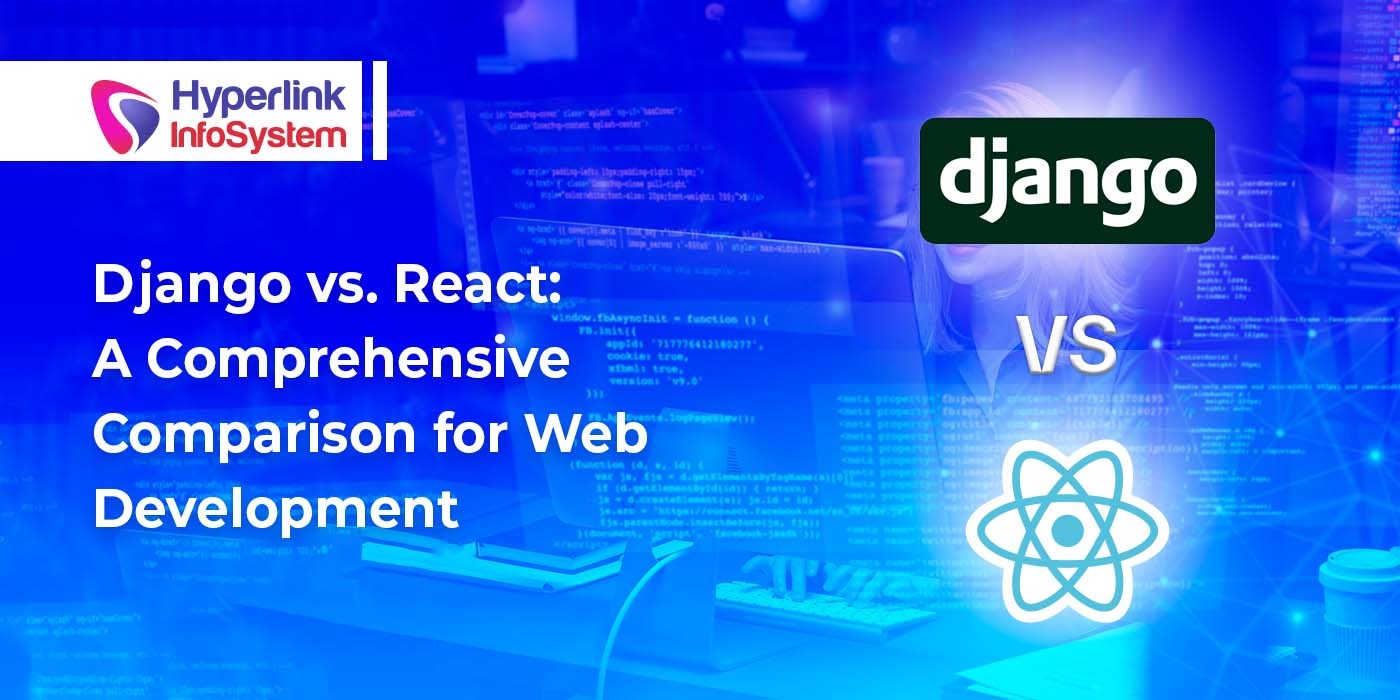In the dynamic realm of web development, the choice of framework carries profound significance. It is the fulcrum upon which the success of digital endeavors pivots. This article delves into the pivotal decision-making process, focusing on two titans: Django and React.
Django, an exemplar of backend prowess, hails from the Python ecosystem, boasting an array of features and tools for robust
web application development. On the other flank, React, a JavaScript library, spearheads frontend innovation, delivering dynamic, interactive user interfaces. This introductory section sets the stage for a comprehensive exploration of their merits, demerits, and judicious utilization in web development.
Django: A Deep Dive
Overview of Django as a Python Web Framework
Django framework, steeped in Pythonic elegance, stands as a robust web framework revered for its high-level abstractions and rapid development capabilities. It champions the Don't Repeat Yourself (DRY) principle and the Model-View-Controller (MVC) architecture, streamlining application development.
Key Features and Advantages
Django's arsenal boasts ORM for database abstraction, built-in admin interfaces, and an extensive library of reusable components. It champions security with measures like Cross-Site Request Forgery (CSRF) protection and SQL injection prevention.
Django finds its forte in various domains, including content management systems, e-commerce platforms, and data-driven applications. It thrives in sectors like publishing, fintech, and government where security and scalability are paramount.
-
Community Support and Resources
The Django community is a wellspring of support, offering a plethora of documentation, tutorials, and packages. This vibrant ecosystem fosters innovation and problem-solving.
-
Limitations and Challenges
Despite its strengths, Django faces challenges in real-time applications and front-end interactivity. Its monolithic structure may pose limitations for microservices architectures and unconventional project requirements.
React: Unveiling the JavaScript Library
In the realm of JavaScript libraries, React emerges as a formidable force, offering a window into its nuances.
Introduction to React as a JavaScript Library
React, a JavaScript library developed by Facebook reigns supreme in building dynamic, component-based user interfaces. Its Virtual DOM and unidirectional data flow optimize performance.
Fundamental Concepts and Benefits
React's foundation rests on concepts like components, JSX (JavaScript XML), and state management. These concepts foster modularity and reusability, driving efficiency in UI development.
-
Ideal Project Scenarios for React
React excels in projects demanding rich, interactive user interfaces, such as single-page applications (SPAs) and progressive web apps (PWAs). It shines in scenarios necessitating frequent updates and seamless user experiences.
-
Thriving React Community and Ecosystem
Backed by a fervent community, React thrives on open-source contributions, third-party libraries like Redux and React Router, and an ever-evolving ecosystem. This support fuels innovation and rapid development.
-
Drawbacks and Learning Curve
While React offers remarkable advantages, it presents a learning curve, particularly for developers new to its paradigm. Additionally, its focus on the view layer necessitates integration with other tools and libraries for complete web application development.
This deep dive into Django and React illuminates their inner workings, strengths, and weaknesses, aiding developers in making informed decisions for web development projects.
Comparing Django and React
Delving into the realm of comparison, we dissect the critical facets differentiating Django and React.
1) Programming Languages
Python vs. JavaScript: Django, steeped in Python, offers a robust backend solution. In contrast, React, built-in JavaScript, primarily focuses on front-end user interfaces. The choice hinges on whether you prefer the elegance of Python or the versatility of JavaScript.
2) Architecture: Full Stack vs. Frontend
Django embodies a full-stack framework, covering both backend and frontend aspects. React, conversely, is purely a front-end library. The choice depends on the project's architectural requirements.
3) Scalability and Performance Considerations
Django's structured approach facilitates scalability for complex applications. React, focusing on UI rendering, excels in high-performance frontend tasks. The choice hinges on the specific scalability needs of your project.
4) Learning Curve and Developer Resources
Django offers an extensive documentation base and vibrant community support. React, too, enjoys a robust ecosystem with numerous resources. The learning curve differs based on your familiarity with Python or JavaScript.
5) Building User Interfaces
Templates vs. Components: Django leans on templates for frontend rendering, while React champions component-based UI development. The choice revolves around your preference for templating or component-driven architecture.
6) Data Handling and APIs
Django's ORM simplifies database operations, making it a strong choice for data-intensive applications. React thrives when interacting with APIs, especially in single-page applications.
7) Security and Authentication
Django, renowned for its security features, includes built-in authentication and protection mechanisms. React, as a frontend library, relies on backend systems for authentication.
8) SEO-Friendliness
Django's server-side rendering supports SEO optimization out of the box. React, being a client-side library, requires additional configurations for SEO-friendly rendering.
9) Community and Support
Both Django and React boast active communities and robust support ecosystems. Your choice may come down to the specific needs and preferences of your development team.
When to Choose Django for Web Development
Examining scenarios where Django shines, we discover the ideal use cases and real-world examples.
-
Scenarios Where Django Shines
Django excels in projects requiring comprehensive backend and frontend capabilities. It shines in content management systems, e-commerce platforms, and data-driven applications.
-
Best Practices for Leveraging Django's Strengths
Gain insights into best practices for harnessing Django's strengths, from structuring applications to optimizing database queries and caching strategies.
When to Choose React for Web Development
Examining the scenarios in which React excels and how to optimize its potential.
-
Situations Ideal for React Development
React shines in projects demanding dynamic user interfaces, real-time updates, and seamless user experiences. Explore scenarios where React's component-based architecture thrives.
-
How to Harness React's Potential for UI-Intensive Projects
Discover strategies and best practices for leveraging React's potential in UI-intensive projects. Explore tips for structuring components, managing state, and optimizing performance.
-
Making the Decision: Django, React, or Both?
Guidance on making the ultimate decision and exploring hybrid possibilities.
Factors to Consider When Choosing Between Django and React
Delve into the critical factors that influence the choice between Django and React. Consider project requirements, team expertise, scalability needs, and architectural considerations.
-
Case for a Hybrid Approach
Consider a hybrid approach that harnesses the strengths of both Django and React. Evaluate scenarios where this approach can lead to a more versatile and efficient web development process.
Conclusion
In the dynamic
realm of web development, the choice between Django and React is akin to selecting the right tools for a craftsman's trade. Each possesses its unique strengths, suited to distinct project requirements.
Whether you opt for the full-stack capabilities of Django or the UI prowess of React, the decision hinges on careful consideration of your project's intricacies. Moreover, as the digital landscape evolves, hybrid approaches marrying both technologies are increasingly viable.
For your Django development, React Native development, or any web development endeavors, partnering with a top-tier website development company is pivotal. Don't hesitate to
hire web developers or dedicated developers with expertise in these domains to sculpt your digital vision into reality.























